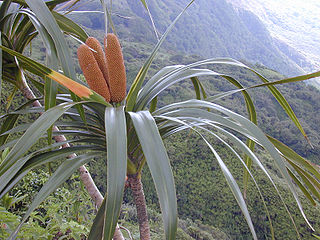
Freycinetia is one of the five extant genera in the flowering plant family Pandanaceae. As of November 2024, the genus comprises approximately 300 species. The type species is Freycinetia arborea.
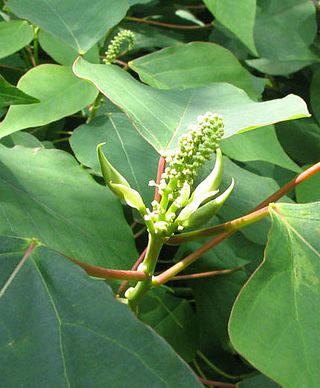
Homalanthus is a genus of plants in the family Euphorbiaceae, first described in 1824. It is the only genus in the subtribe Carumbiinae. It is native to mainland Southeast Asia, Malesia, Papuasia, northern and eastern Australia, and various islands in the Pacific.

Chrysobalanaceae is a family of flowering plants, consisting of trees and shrubs in 27 genera and about 700 species of pantropical distribution with a centre of diversity in the Amazon. Some of the species contain silica in their bodies for rigidity and so the mesophyll often has sclerenchymatous idioblasts. The widespread species Chrysobalanus icaco produces a plum-like fruit and the plant is commonly known as the coco plum.
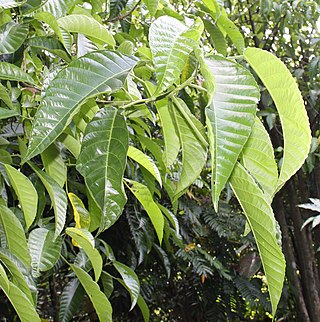
Dendrocnide is a genus of approximately 40 species of plants in the nettle family Urticaceae. They have a wide distribution across North East India, Southeast Asia, Australia and the Pacific Islands. In Australia they are commonly known as stinging trees.
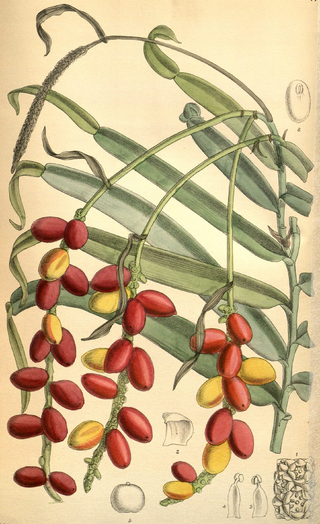
Pothos is a genus of flowering plants in the family Araceae. It is native to China, the Indian Subcontinent, Australia, New Guinea, Southeast Asia, and various islands of the Pacific and Indian Oceans.

Heritiera littoralis, commonly known as the looking-glass mangrove or tulip mangrove, is a mangrove tree in the family Malvaceae native to coastal areas of eastern Africa, Asia, Melanesia and northern Australia. The common name refers to the silvery appearance of the underside of the leaves, resembling a mirror to some degree. The strong timber has uses in marine applications and elsewhere.

Barringtonia is a genus of flowering plants in the family Lecythidaceae first described as a genus with this name in 1775. It is native to Africa, southern Asia, Australia, and various islands of the Pacific and Indian Oceans. The genus name commemorates Daines Barrington.
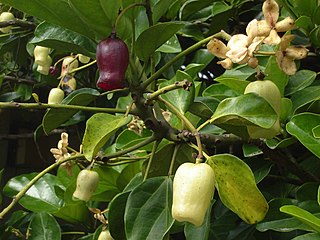
Atuna is a genus of plants in the family Chrysobalanaceae described as a genus in 1838. It is native to the Indian Subcontinent, Southeast Asia, and various islands of the western Pacific.

Fagraea is a genus of plants in the family Gentianaceae. It includes trees, shrubs, lianas, and epiphytes. They can be found in forests, swamps, and other habitat in Asia, Australia, and the Pacific Islands, with the center of diversity in Malesia.
Hunga is a genus of plants in the family Chrysobalanaceae described by British botanist Ghillean Prance in 1979. Species in this genus are native to New Guinea and New Caledonia.
Kostermanthus is a genus of plants in the family Chrysobalanaceae described by British botanist Ghillean Prance in 1979. Species in this genus are large trees native to Malesia.

Parinari is a genus of plant in the family Chrysobalanaceae.
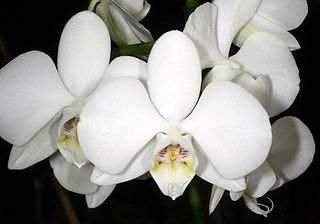
Phalaenopsis amabilis, commonly known as the moon orchid, moth orchid, or mariposa orchid, is a species of flowering plant in the orchid family Orchidaceae. It is widely cultivated as a decorative houseplant. It is an epiphytic or lithophytic herb with long, thick roots, between two and eight thick, fleshy leaves with their bases hiding the stem and nearly flat, white, long-lasting flowers on a branching flowering stem with up to ten flowers on each branch.
Cathormion is a genus of flowering plants in the family Fabaceae. It contains a single species, Cathormion umbellatum, a shrub or tree which ranges from India to Indochina, Sumatra, Java, Sulawesi, the Lesser Sunda Islands, Maluku, New Guinea, and northern Australia.

Cassia javanica, also known as Java cassia, pink shower, apple blossom tree and rainbow shower tree, is a species of tree in the family Fabaceae. Its origin is in Southeast Asia, but it has been extensively grown in tropical areas worldwide as a garden tree owing to its beautiful crimson and pink flower bunches.

Atuna racemosa subsp. racemosa is a subspecies of Atuna racemosa, a plant species in the family Chrysobalanaceae.

Atuna excelsa subsp. racemosa, synonym Atuna racemosa, is a tree in the family Chrysobalanaceae. The epithet racemosa is from the Latin meaning 'clustered', referring to the inflorescence. The tree is widely known as tabon-tabon in the Philippines, where the fruits have been traditionally used for the preparation of kinilaw for almost a thousand years.

Cephalomanes atrovirens is a species of fern in the family Hymenophyllaceae. The genus Cephalomanes is accepted in the Pteridophyte Phylogeny Group classification of 2016, but not by some other sources. As of October 2019, Plants of the World Online sank the genus into a broadly defined Trichomanes, while treating the subtaxa of this species as the separate species Trichomanes acrosorum, Trichomanes atrovirens, Trichomanes boryanum and Trichomanes kingii.

Syzygium racemosum, the wax jambu, is a species of flowering plant in the family Myrtaceae. It is native to Thailand, Peninsular Malaysia, Java, the Lesser Sunda Islands, and Borneo. A tree reaching 37 m (120 ft), it is occasionally harvested for its timber, and a black dye can be made from its bark.
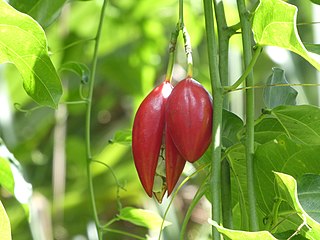
Adenia heterophylla, commonly known in Australia as the lacewing vine, is a climbing plant in the family Passifloraceae. It has a broad distribution spanning the equator, from the south eastern corner of China, through Indochina and Malesia, to northern Australia. In Australia it serves as a food plant for larvae of the glasswing, red lacewing and cruiser butterflies.














